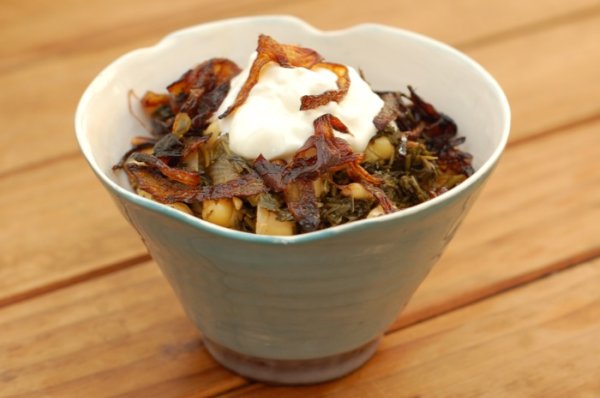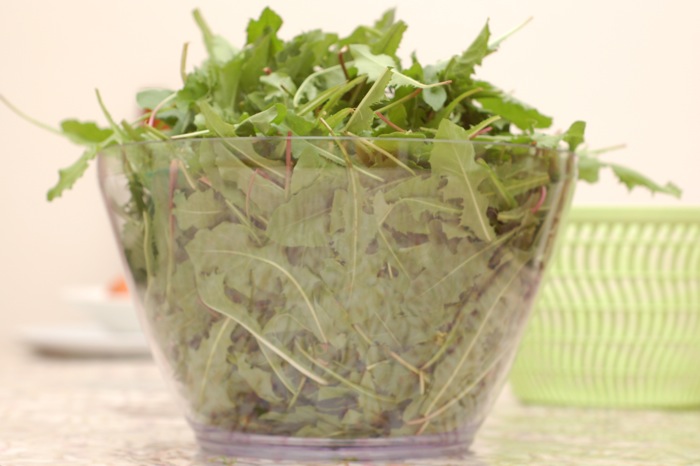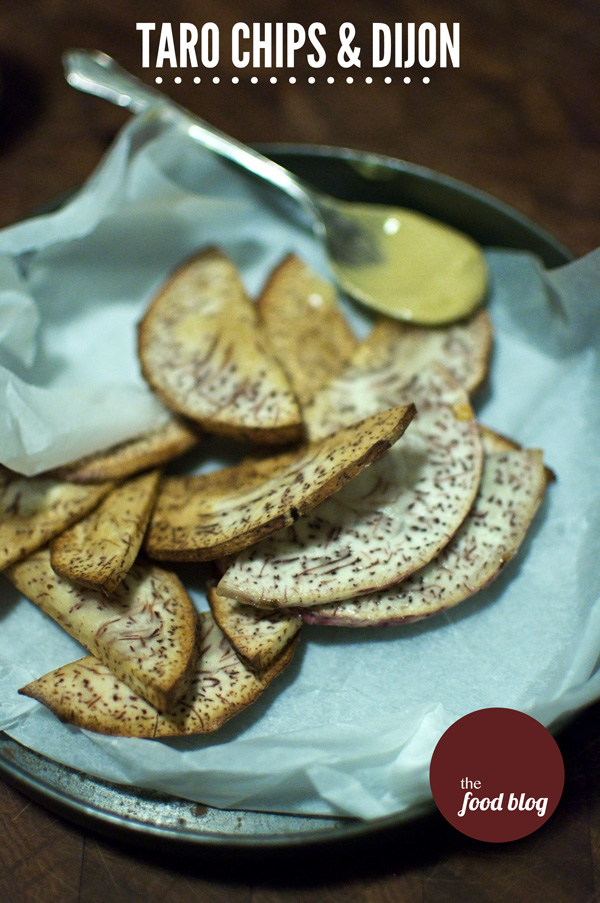
Lebanese style dandelion leaves
Before I begin this entry, I want to direct your attention to the ceramic bowl above which I made in December. This one is my pride and joy.
OK. Let’s start.
Talk to any real food lover out there and they will sing the praise of simple, honest, traditional food. One might be seduced by the luxury of foie gras, the aromatic intensity of truffles or mesmerising power of silky wagyu beef, but it’s easy to get something ethereal out of ingredients that are so good (and expensive) to start off with. But in my opinion, real ingenuity comes from creating flavour out of ingredients that are undervalued, humble, or even down right met with disdain. Having gone through several famines, my Lebanese ancestors have had to put their devious talents where their mouth is and derive their nutrition from the least likely of plants and cuts of meat. One example is akkoob (gundelia tournefortii, ????), a thorn that grows in the high mountains of Lebanon and in Syria and Jordan. This thorn is notoriously difficult and painful to harvest and its preparation is equally hazardous. But what you are left with, apart from green-hued bleeding fingers is a stem that works culinary wonders in stews, stir fries and with eggs. What drove someone to identify this wicked thorn as a potential source of food is beyond me. My guess is nothing short of extreme hunger.
Another such example of unlikely food is the dandelion (??????). In Australia, dandelion is mostly considered a lawn weed suitable only to feed guinea pigs, yet it is widely loved in Lebanon and is the main ingredient and namesake of the popular dish hindbeh. Dandelion gets its name from the French dent de lion, meaning lion’s tooth, in reference to the serrated shape of the leaf. Dandelions might be commercially grown in Lebanon, but most families I know gather their supplies from the wild, or buy it from the forager. So while Lebanese children are picking the dandelion flowers and making a wish before blowing on the parachute-like seeds (the wish comes true if the seeds fly in the direction you chose earlier), the savvy, cost-conscience mothers are busy harvesting.

dandelions growing wild in a garden in Portland NSW
The dandelion could be mistaken for other weeds with similar but hairy/thorny leaves (ones whose name I do not know, so avoid hairy leaves please). The smooth dandelion leaf is best harvested in early spring if intended to be eaten raw in salads, as its bitter flavour has not fully developed. As the leaf matures, it grows larger, thicker and more bitter. This bitterness can be minimised by blanching or by washing thoroughly and then squeezing out the liquid. However, bitterness is not a bad thing, as most naturopaths will tell you. It is usually an indicator of a plant’s ability to detoxify the body and the liver (or that the plant is poisonous!). Dandelions are high in protein, naturally diuretic and anti-inflammatory and are rich in potassium and beta-carotene and many other highly beneficial minerals, which is why this humble plant has been very popular in herbal medicine.
This time of year sees a proliferation of dandelions in New South Wales, and since I am a lover of wild/foraged food, I did not want to miss the opportunity to feast on dandelions this year. A brief half hour walk down the road in Earlwood resulted in 400 grams of fresh dandelion leaf. Sure, the neighbours looked on suspiciously, the dogs barked madly and the joggers gazed in distrust. But don’t let that stop you. The sunshine and the buzz you get out of collecting your own food is alone worth it. But to make things even better, this is a recipe for hindbeh, our favourite way of cooking dandelion. The idea is to fry the leaf with garlic and onions in olive oil until it is almost dry, and then it would be ready to absorb the lemon juice you add. It is then topped with caramelized onions and eaten cold. To make mine a bit more of a proper meal, I added chickpeas, toasted pine nuts and a nice dollop of yoghurt on top. Such classic Lebanese flavours. It’s too cheap to be true.
NOTE: If dandelions are not available, you can substitute them with endive (available at supermarkets)

half an hour’s worth of dandelion foraging
Hindbeh – Dandelion Recipe
Preparing the Dandelions
- When you pick the dandelions, make sure you don’t pick other weeds with them and be careful of insects such as spiders. You should find dandelions grown in lawns and on sidewalks.
- Chop the dandelions finely, wash thoroughly in several changes of water and drain. Wrap the leaves in a tea towel and twist the tea towel to drain all the excess water and bitterness.
- Taste a dandelion leaf. If it is not too bitter, then it should be good to cook. If it is (and by bitter, I mean BITTER), blanch the dandelions in boiling water and 1/2 a tsp of sodium bicarbonate for 3 to 5 minutes. It’s preferable not to blanch if you can handle the bitterness.
Cooking the Dandelions (Hindbeh)
Ingredients
500 g dandelion leaf, prepared as above (weighed before blanching)
4 large onions, cut in thin wings (halved, then diced vertically)
4 cloves of garlic, finely chopped
½ cup olive oil
½ cup lemon juice
2 tsp salt
1 cup boiled chickpeas (optional)
½ cup Greek style yoghurt (optional)
2 tbsp toasted pine nuts (optional)
Method
- In a large frypan, heat up the olive oil and fry the onions with a tsp of salt on a gentle heat
- When the onions are slightly golden, remove half of them and set aside
- Continue to fry the onions, stirring every couple of minutes until they caramelise. Turn the heat down if they are cooking too quickly and keep a watchful eye, as they burn very easily
- Once caramelised, remove the onions, and keep the oil in the frypan
- Using the same oil, add the half cooked onions you removed earlier and the garlic and fry until the garlic begins to turn golden
- Add the dandelion leaf and the remaining salt. It might look like too much in the frypan, but the volume will drop significantly once cooked for a minute or two
- Keep cooking, stirring every couple of minutes until most of the moisture in the dandelion has evaporated. The colour should be getting dark, but not burn. The ingredients will begin to stick to the bottom of the pan. Keep cooking for 5 minutes, turn off the heat and add the lemon juice
- The dandelion leaf will absorb the liquid quickly. You can now set aside to cool and then refrigerate
- Once cool, you can toss in the boiled chickpeas (cold) and the pine nuts. Top with yoghurt and then the caramelised onions and enjoy

17 comments
This recipe makes me want to forage in my back yard for dandelions!
Wow! I so enjoyed this post! This is what I call a "Master class"; so informative and so interesting and with humorous moments too. I could picture the neighbors looking at you very suspiciously (do they know you are "an arab" too?)
Anyway, this is my favorite dish! Oh I love it so much! Especially with some pine nuts!
yummm! I love dandelion! My parents forage in our hometown spring to fall, they get all sort of herbs including rocket, purslane and one call kors aanneh (dunno english name) and so on. Mom makes hindbeh as a side dish usually so I never thought of making more filling. Yogurt and pine nurs seem intersting…
Love the ceramic bowl that you made! You should definitely be proud of it 😀 Ahh, so it was you that was lurking around outside picking dandelions! Lol. j/k! I never knew so much about dandelions, thank you! And this looks lovely!
ivorypomegranate – do! but you need a fair bit since it shrinks a lot when it looses moisture
joumana – thanks! I try my best, as you know 🙂 luckily, taking a blonde aussie wife along lowers suspicion
viviane – korsanneh (one word) is called "field eryngo", botanical name "eryngium creticum". you must try it with yoghurt, chickpeas and pine nuts. it's a meal one its own. really great
betty – thanks! I love it too 🙂 I didn't reach as far as marrickville hehehe. More than happy to take you out for a forage if you want. But be quick before the season is over. How did you like the jam?
What an informative post! I don't think I have ever given the dandelions much thought. Thank you for posting it!
Very nice post. I love dandelion. It is clutivated commercially in the US (mostly grown in California) so we are missing out on the whole foraging experience 😉
I like it raw rather than cooked. It serves as an excellent substitute for endive in salads. I also use it in liue of collard greens in lentil soup (shorbet adas b hamod. I also sneek it into my son's spaghetti for added nutrional value.
Cheers,
Dana
@Fouad
I can't believe I didn't come across your blog before.
Really really good work. I love the cooking, I love the recipes and I love the photography.
Hey Fouad,
The Taste-Buds think you deserve the honest award check it out here:
http://thetastebudz.wordpress.com/2010/01/31/the-honest-award-10-things-to-hate-about-us/
great post! i love traditional lebanese food – but maybe that's coz i'm lebanese. I also have a food blog, just started it a few days ago – come by anytime 🙂 http://www.samahsrecipes.blogspot.com
best regards and keep up the yummy work!! 😀
Oooohhh I love this. This was one of my favorite dish. I wonder if I can find dandelion in Paris. I am sooo happy I found your blog. I am lebanese too & I live in paris. Will continue now checking your yummy recipes 🙂
snacksgiving – you're welcome
Dana – foraging is so much fun. I'm sure you can still find it growing wild if you look closely enough 🙂 Good ideas with the shorba!
Kano – Thanks for your kind words and for your great blog. I've added it to my links list and will be following it for sure 🙂
Viviane – thank you so much
Samah – thanks. Good luck with your new blog. Keep it up and enjoy
Chirine – thanks for all your comments and for reading. Let me know if you find any dandelions in Paris 🙂
Cooked this tonight and had it as an entree, hot from the pan rather than cooling it down.
Also added the chickpeas to the pan to heat up just before the end of cooking. Was absolutely delicious – the contrast of the tangy lemon with the bitterness of the greens and the sweetness of the caramelised onions – amazing!
Thanks so much for sharing – I never knew the weeds in my garden had so much to offer!! 🙂
Cheers
Christine
Hi Christine. Thanks for trying the recipe and sharing. I love hearing success stories 🙂
How good are those onions with it? Man I love that dish! Make sure you leave some to be eaten cold. It’s the traditional way of eating it.
Fouad
We’re having guests who can’t eat any nightshade vegetables (which knocks out almost everything Lebanese!), so I decided on hindbeh, but every recipe I could find in my standard cookbooks required blanching. It robs many of the nutrients, so I was glad to find “permission” here to cook it without blanching…looking forward to serving it tomorrow, though I will definitely have to call it “hindbeh,” as I can already hear my husband going on about serving guests “weeds.”